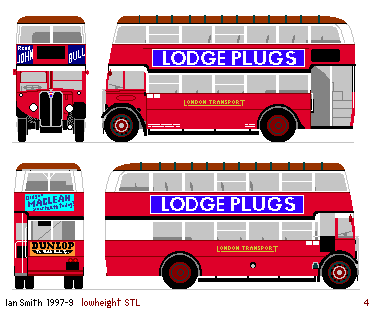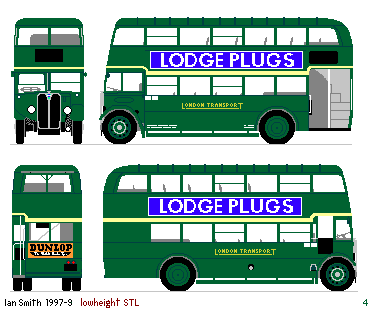
Chiswick Lowbridge STLs

The Chiswick Lowbridge STLs, 4/9STL13 (total 20)
STL1617, 1954/55/59/73/74/78/90, 2107/48/86, 2217/20/29/32/50/73/91/92, 2311. Total 20
 The war brought different travel patterns to London,
partly through reduction in personal transport,
and also in the massively-increased production in armaments and war-related production.
Several routes in London that were the province of single deckers became overloaded,
and increasing the frequency using displaced single-deckers was not practical given the staffing difficulties.
London had not operated lowbridge buses in the Central Area, as they were frowned upon by the Police.
(Presumably their odd layouts were thought to cause delays at stops).
The war brought different travel patterns to London,
partly through reduction in personal transport,
and also in the massively-increased production in armaments and war-related production.
Several routes in London that were the province of single deckers became overloaded,
and increasing the frequency using displaced single-deckers was not practical given the staffing difficulties.
London had not operated lowbridge buses in the Central Area, as they were frowned upon by the Police.
(Presumably their odd layouts were thought to cause delays at stops).
But now there was a need, particularly in the Morden and Harrow areas.
The Country Area was not able to help much with the problem,
as its own lowbridge routes - the 336 and 410 - were under pressure from increased demand.
It wasn't that the lowbridge STs were failing.
Far from it - they were being cared for and worked hard on the 336.
The Godstone STLs were doing their bit too: the 410 route, linking
Bromley and Redhill/Reigate, passed the very end of Biggin Hill's
runway (that isn't why it was a lowbridge route, although it sometimes felt that way!).
The public road was closed for part of the war, which cut the route in two.
This meant that the northern part, from Bromley to Biggin Hill, could be operated by
normal-height double deckers operating from Dunton Green,
and a linking route via the narrow lanes could be operated by a Cub or a Q.
But this meant that for a while a group of Godstone STLs could be loaned to Watford,
until released by the arrival of the new buses.
In turn Watford could lend some
of its STs to Sutton for use on the new Morden lowbridge route 127,
that was being too heavily used for single-deckers to cope with.
Meanwhile the 230 route Between Rayners Lane and Northwick Park,
in north-west London was also overloaded, using high capacity single-deckers.
The arrival of new lowbridge types (the Chiswick buses,
some lowbridge buses amongst those borrowed from elsewhere, and later the Daimler utilities)
allowed these traffic density problems to be resolved.
 The new buses were a recognisably Chiswick product in outline:
London Transport had been allotted a small build of bodies to fit the "unfrozen" AEC chassis,
but was allowed to build them in a lowbridge version.
They eschewed the angular outlines of the standard austerity designs,
but had certain austerity features: a smaller number of opening windows,
austerity seating, single-panelling, no rear display, and a reduced front display.
The new buses were a recognisably Chiswick product in outline:
London Transport had been allotted a small build of bodies to fit the "unfrozen" AEC chassis,
but was allowed to build them in a lowbridge version.
They eschewed the angular outlines of the standard austerity designs,
but had certain austerity features: a smaller number of opening windows,
austerity seating, single-panelling, no rear display, and a reduced front display.
The chassis were second-hand from roofbox STLs.
Although they originated as bodies for unfrozen chassis,
London Transport was allowed to swap bodies around,
so that this type went onto reliable chassis with fluid flywheels and preselector gearboxes.
London Transport wanted these buses to work!
They were delivered in the red and white livery (with brown roof),
irrespective of their original location. Later some had the red replaced by green,
and at least one had a repaint into post-war green livery, with a cream band.
When the Godstone STLs were withdrawn
from Godstone in 1950 for major overhaul,
the Chiswick buses helped fill the gap,
along with some hired Bristol lowbridge buses,
until the RLHs arrived.
The lowbridge STLs bowed out early in 1953. A few were relicensed in June for the Coronation period.
Several went on for service elsewhere, such as with Hants & Sussex (who took four).

 the lowbridge bus histories
the lowbridge bus histories
 photographic references
photographic references

 Bus Stop
Bus Stop
 contents
contents
 Tunnel
Tunnel
 lowbridge.
lowbridge.
 unfrozen STLs.
unfrozen STLs.
|

 The war brought different travel patterns to London,
partly through reduction in personal transport,
and also in the massively-increased production in armaments and war-related production.
Several routes in London that were the province of single deckers became overloaded,
and increasing the frequency using displaced single-deckers was not practical given the staffing difficulties.
London had not operated lowbridge buses in the Central Area, as they were frowned upon by the Police.
(Presumably their odd layouts were thought to cause delays at stops).
The war brought different travel patterns to London,
partly through reduction in personal transport,
and also in the massively-increased production in armaments and war-related production.
Several routes in London that were the province of single deckers became overloaded,
and increasing the frequency using displaced single-deckers was not practical given the staffing difficulties.
London had not operated lowbridge buses in the Central Area, as they were frowned upon by the Police.
(Presumably their odd layouts were thought to cause delays at stops).
 The new buses were a recognisably Chiswick product in outline:
London Transport had been allotted a small build of bodies to fit the "unfrozen" AEC chassis,
but was allowed to build them in a lowbridge version.
They eschewed the angular outlines of the standard austerity designs,
but had certain austerity features: a smaller number of opening windows,
austerity seating, single-panelling, no rear display, and a reduced front display.
The new buses were a recognisably Chiswick product in outline:
London Transport had been allotted a small build of bodies to fit the "unfrozen" AEC chassis,
but was allowed to build them in a lowbridge version.
They eschewed the angular outlines of the standard austerity designs,
but had certain austerity features: a smaller number of opening windows,
austerity seating, single-panelling, no rear display, and a reduced front display.
 the lowbridge bus histories
the lowbridge bus histories Bus Stop
Bus Stop contents
contents Tunnel
Tunnel lowbridge.
lowbridge.